
phad paintings were originally intended as portable temples, these artworks were taken on the road by religious leaders of the Rabari tribe known as Bhopas and Bhopis, who would sing and perform tales about their local deities, Devnarayanji, an incarnation of Krishna,
Phad Painting is a traditional scroll painting style from Rajasthan, India, known for its vivid colors, intricate details, and narrative storytelling. Originating over 700 years ago, this art form was primarily used to depict the heroic deeds of local deities and folk heroes, especially Pabuji and Devnarayan.
Painted on long pieces of cloth or canvas (called Phads), these artworks served as mobile temples for the Bhopas, the priest-singers who traveled from village to village performing the stories illustrated in the scrolls. The paintings are typically done using natural colors derived from stones, flowers, and minerals.
Key features of Phad painting:

In this artwork, Hanuman Ji is often shown:
Carrying the Dronagiri Parvat with Sanjeevani herbBowing in devotion to Lord Ram and Sita
In a dynamic battle pose against demons
Surrounded by rich, earthy Rajasthani motifs
Painted with natural dyes and pigments, the scroll is alive with symbolism and emotion — capturing Hanuman Ji’s bhakti (devotion), bal (strength), and seva (service) in every brushstroke.
Whether for a home altar, gallery wall, or cultural display, this painting is both a spiritual and artistic treasure.

Vivah Phad Painting is a vibrant depiction of traditional Indian wedding ceremonies, portrayed in the distinctive storytelling style of Rajasthan’s ancient Phad art. These paintings are not just visual treats — they’re cultural narratives that celebrate the union of two souls with all the rituals, music, and joy that define a traditional Hindu wedding.
Typical scenes in a Vivah-themed Phad may include:
-
Baraat (groom’s procession)
-
Phere (sacred wedding rounds around the fire)
-
Kanyadaan (giving away the bride)
-
Mehendi and Haldi rituals
-
Doli (bride’s farewell)
Every figure and moment is painted in flat, bold colors, filled with expressive gestures and surrounded by floral and geometric folk motifs. The art uses natural pigments in earthy tones like ochre, red, green, and black, and is usually painted on cloth scrolls.
This Phad serves as both an artistic treasure and a celebration of India’s rich matrimonial traditions — perfect for decor, gifting, or cultural exhibitions.
🖌️ Phad Painting Method: Step-by-Step
-
Preparation of the Canvas (Cloth or Scroll):
-
A thick cotton cloth is soaked in water, then starched with rice or wheat flour and dried.
-
Once dry, it is rubbed with a khaddar stone (smooth stone) to create a leathery, smooth surface suitable for painting.
-
-
Sketching the Design:
-
Artists begin with a rough sketch using a fine bamboo stick (kalam) dipped in black pigment.
-
The composition is laid out in a way that tells a continuous narrative — usually from right to left or top to bottom.
-
-
Color Filling (Traditional Order):
Phad painting follows a specific order of applying colors, from lighter to darker tones:-
Yellow – for ornaments and base skin tone
-
Orange (Geru) – for clothing and background elements
-
Green – for trees, vegetation, and accessories
-
Brown – for architectural elements
-
Red – for clothes and emphasis
-
Blue – very rarely used, traditionally avoided
-
Black – for outlines and final detailing
-
White – for highlights and decorative details
-
-
Natural Color Preparation:
All colors are made from natural materials:-
Yellow: From stones like yellow ochre
-
Red: From geru (red clay) or vermilion
-
Green: From indigo leaves or plant extracts
-
Black: From lamp soot or burnt coconut shells
-
White: From chalk powder or lime
-
-
Outlining and Final Touches:
-
Once all the colors are filled, the figures and elements are outlined with black, giving the art its characteristic bold look.
-
Intricate patterns, borders, and details are added at the end.
-
-
Drying and Preservation:
-
The finished Phad is dried in shade and often rolled (never folded) for storage.
-
It’s considered sacred, especially when depicting gods or folk deities, and is sometimes blessed before use.
-
🎨 Phad Art Is Not Just Painting — It’s Storytelling Through Ritual and Tradition.
The process is often a community effort, passed down generations, especially by the Joshi families of Bhilwara, Rajasthan, who are the traditional custodians of this art form.
